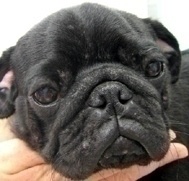






Tierdermatologie Deisenhofen
Diese Seite wird noch übersetzt!
Alopecia
Alopecia is correctly defined as a complete loss of hair. It can occur at a
single site, or in a multifocal or patchy pattern. Hypotrichosis is sometimes
called partial alopecia, it is perhaps helpful to think of hypotrichosis as a
thinning of the haircoat.
When examining a case of alopecia it is important to distinguish carefully
between: inflammatory and non-inflammatory alopecia, because each of these
is generally associated with a different group of differential diagnoses.
Inflammatory alopecia:
Erythema, epidermal collarettes, excessive scaling, oily seborrhoea,
comedones, papules and pustules are all lesions which give clues for
inflammation.
Common infectious causes of inflammatory alopecia include demodex,
dermatophytes, bacteria and yeast. Demodex and dermatophytes cause alopecia as a direct result of their presence within the hair follicles/ on the hair shafts and then additionally sometimes as a result of an associated pruritus.
It is unusual for a primary hypersensitivity to cause inflammatory alopecia without the presence of a secondary infection. The presence of bacteria and yeast is typically secondary to an underlying hypersensitivity or hormonal disease.
Non-inflammatory alopecia:
Hairloss, complete or partial (hypotrichosis) with no other skin abnormalities is
typically associated with either an endocrine or primary follicular growth
abnormality - such as a follicular dysplasia. It is however, also seen in early stage demodecosis and dermatophytosis and with some unusual diseases such as alopecia areata.
Hyperpigmentation is associated with endocrinopathies and can be a post-inflammatory change, but may be a non-specific accompanying sign secondary simply to the loss of the hair.
Alopecia is correctly defined as a complete loss of hair. It can occur at a
single site, or in a multifocal or patchy pattern. Hypotrichosis is sometimes
called partial alopecia, it is perhaps helpful to think of hypotrichosis as a
thinning of the haircoat.
When examining a case of alopecia it is important to distinguish carefully
between: inflammatory and non-inflammatory alopecia, because each of these
is generally associated with a different group of differential diagnoses.
Inflammatory alopecia:
Erythema, epidermal collarettes, excessive scaling, oily seborrhoea,
comedones, papules and pustules are all lesions which give clues for
inflammation.
Common infectious causes of inflammatory alopecia include demodex,
dermatophytes, bacteria and yeast. Demodex and dermatophytes cause alopecia as a direct result of their presence within the hair follicles/ on the hair shafts and then additionally sometimes as a result of an associated pruritus.
It is unusual for a primary hypersensitivity to cause inflammatory alopecia without the presence of a secondary infection. The presence of bacteria and yeast is typically secondary to an underlying hypersensitivity or hormonal disease.
Non-inflammatory alopecia:
Hairloss, complete or partial (hypotrichosis) with no other skin abnormalities is
typically associated with either an endocrine or primary follicular growth
abnormality - such as a follicular dysplasia. It is however, also seen in early stage demodecosis and dermatophytosis and with some unusual diseases such as alopecia areata.
Hyperpigmentation is associated with endocrinopathies and can be a post-inflammatory change, but may be a non-specific accompanying sign secondary simply to the loss of the hair.
Multifocal areas of
non-inflammatory alopecia and
hypotrichosis in pug with
demodecosis
Alopecia and hypotrichosis
with erythema and
hyperpigmentation and a
marked follicular pattern in a
labrador with demodecosis











